
Photography || Portfolio Site || Blog || About || Contact || Home ||
Local Knowledge Helps
Published in the Winter 2011 issue of the Montana Sporting Journal
By Joshua Bergan
In Montana, some flies catch more fish than others, and local-guide-designed flies are often the ones that catch the most.
Below are five of Montana's productive local patterns, straight from their designers – all either current or former guides with decades of combined Montana fly-fishing experience.
-Pigpen Leech-
by Doug McKnight
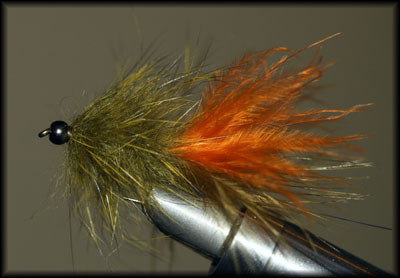
Hook: 2XL nymph/ streamer hook
Bead: Black 5/32 inch
Thread: UTC 140
Tail: Olive and Burnt Orange Marabou tied sparse, single strand of Flashabou tied on the sides of the tail
Body: Hareline Olive Variant Rabbit fur spun in a dubbing loop
From McKnight: “While the Pigpen is designed to imitate a leech, it also imitates damsel & dragonfly nymphs, small baitfish, even a crayfish.”
It was created to bamboozle big stillwater trout, but it will effectively aggravate pigs in moving water, too. If McKnight will accept your Facebook friend request, you can be privy to the truly mammoth fish this fly has caught.
McKnight is available at Big Water Studio.
-Shrimp Cocktail-
by Dave McKee
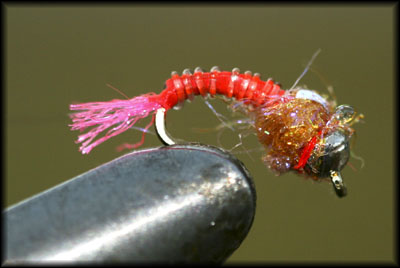
Hook: Tiemco #2457 or Dai Riki #135 size 16
Thread: Pink 6/0
Tail: Flourescent Pink Darlon
Body: Clear Tubing
Wingcase: Rainey's Wing Ribbon
Thorax: Shrimp Pink UV Ice Dub
Says McKee: “Simply came up with it because pink stuff was working really well out there on the Lower Madison a few winters ago and it has continued to be my go-to nymph during February and March out there, as well as on the Missouri, the Upper Madison and the spring creeks in Livingston.”
You can leave off the clear tubing for a more slender fly.
I can vouch for this fly on the lower Madison in the winter – find a good hole, and proceed to pull fish after fish out.
McKee is available at Dave McKee Fly Fishing.
-Brindle 'Chute-
by Chuck Stranahan
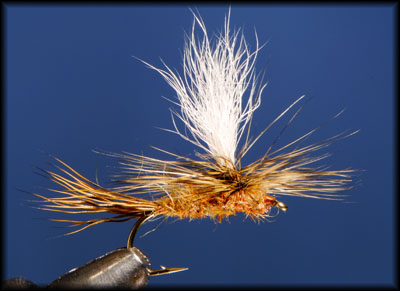
Hook: Standard dry fly
Thread: Rusty brown 6/0
Tail: Deer hair dyed golden brown
Body:Dubbing blend as follows: 2 parts natural hare's ear and antron blend, 1 part orange rabbit and antron blend, 1 part olive and antron blend. Adjust overall shade by adding small amounts of desired color, and then add about 10 percent amber or gold tri-lobal fiber to overall mixture.
Wing:White calf tail
Hackle: Grizzly dyed light golden brown
Says Stranahan: “The fly was originally designed to work for the hecuba mayfly hatch that occurs late summer on the Bitterroot River. It also resembles a wide range of aquatic insects, and because of its unique blend of colors, serves well as a searching pattern when nothing else is going on.”
Some feel the key to this fly is the ultra-secret precisely toned dubbing mixture, which he has zealously guarded for years.
It's one of those flies that catches fish when nothing else will. Just ask his wife, who regularly outfishes all involved with the Brindle 'Chute.
Stranahan is available at Chuck Stranahan's Flies and Guides in Hamilton.
-Thing from Uranus-
by Ben Romans
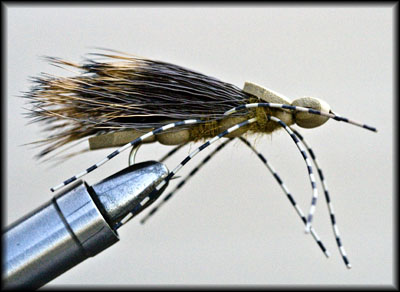
Hook: MFC 6XL 7030, Bronze
Thread: Nymo thread, tan & uni-thread, tan 6/0
Front wing: Elk flank cow, natural
Rear wing: Elk flank cow, natural
Body:Foam, tan
Tail: Foam, tan
Legs: MFC Centipede Legs, speckled tan
According to Romans, the key is its splayed wings. “If you pay attention, salmonflies have two sets of wings that splay, especially when they hit the water and start fluttering madly to get airborne again. However, most popular patterns simply have one elongated wing that stretches from along the body—looking more like the profile of a resting bug than one in a panic. So I decided this new fly should have two sets of splayed wings.”
It rides low and floats forever – what a combination. It'll tow a dropper like a Mack Truck – perfect for attaching stonefly nymphs and fishing a foot off the bank.
And its name derives from an episode of the Simpsons, which the trout like.
Romans is a former Montana fly fishing guide and the former editor of the Fly Fish Journal.
-Parachute Flying Ant-
by Dave Bloom
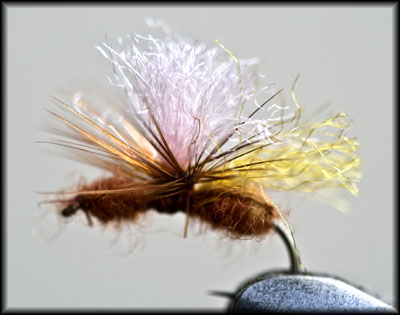
Hook: #12-16 short-shank dry fly
Thread:Uni rusty brown 6/0
Abdomen: Harrop’s dry fly dubbing- rusty spinner under Zelon- caddis amber - covering the top of the abdomen
Hackle: Brown - Whiting
Wing:Zelon - caddis gold
Post:Antron - pink
Head:Harrop’s dry fly dubbing - rusty spinner
This is one that is usable basically anytime, anywhere, but it works especially well on the Craig section of the Missouri River. Says Headhunters Fly Shop's John Arnold: “If I was entering a one-fly contest on the Missouri, I would use his flying ant for a dry.”
Bloom is available at Bloom Outfitting.
Also ask around for Lanier's Lightning Lucent, the Peacock Clacka Caddis, the Royal Wulff Cripple, the Zirdle, Biggie's Sowbug, or Bloom's Tung Dart or Weight Fly and others. It goes without saying that there are many more great local patterns (like anything by Galloup, Mathews, Tollett, Delekta, Lafontaine, etc.).
Many of these flies are produced commercially and will be for sale a the local fly shop.
Google around a bit or ask the fly shop guy or gal for some local flavor. Present these flies well at the right time, and you should have a good day.